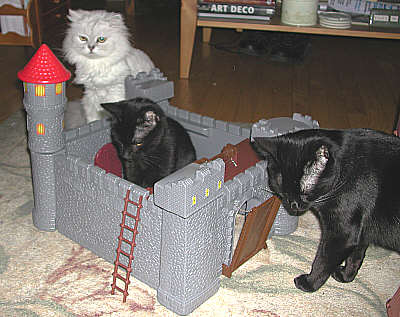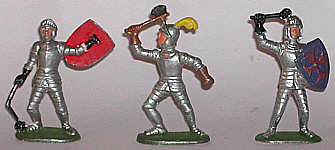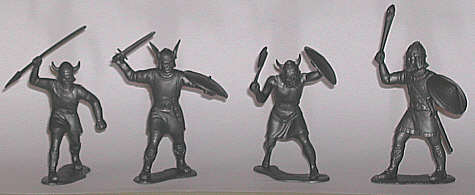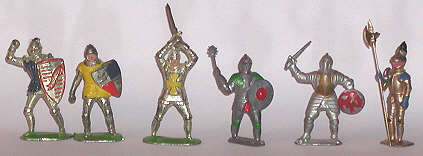
Copyright 2003 T. Sheil & A. Sheil All Rights Reserved


Among the Army men and cowboys and Indians and foreign legionnaires, ever boy had a few medieval figures. These were invariably an assortment of armored knights on foot and horseback. They were heavily armored, with exotic weapons such as halberds, maces, morningstars and battle axes. Most boys had an assortment that included fellows in plate armor and others in chainmail. Looking at them many decades later, it is amazing just how realistic they were.
Realism! Most of the knights were outfitted authentically. It is obvious now that the sculptors did some research to make "proper" armor. The poses were exciting, too. Of course, realism was tempered with excitement. Our knights' authenticity was challenged by how they were sold. Most sets included knights from several eras. It was not uncommon to see figures modeled after the men of 1291 standing side-by-side with warriors of 1525.
Our knights would be "paired off" by color, in most cases. Some makers produced their figures in gold and silver, making two distinct armies. Others used a host of colors, one making metallic versions of primary colors while another was content to use the same reds and whites as it used for cowboys and Indians. A toy medieval army could be very colorful!
There were other armies out there. Some castles featured knights versus Vikings. The Norse Army more resembled the Germanic warriors of the downfall of Rome. They were green, packed in with a set of knights wearing post-1450 armor and a tin-litho castle. Vikings were considered cool. Other Medieval adversaries did not make it into US battlefields. American toymakers did not produce Saracens or Mongols. A few boys may have had sets of them from European makers, but none were made here.

On the sidelines were a few lucky kids who managed to get English imports. Johillco and Britains appeared here and there. As Plastic replaced metal, the Herald line of knights could emerge at any time. They were painted and some had separate weapons. Equally exotic were Elastolin figures. They were even rarer, although a relative stationed in Germany might send a few. For most of us, our knights came from makers like Marx, Lido, Tim Mee, Ideal and MPC.
Children knew about knights from several sources. On television were a few knightly shows, such as "Ivanhoe" and "The Vikings." Also popular were reruns of Errol Flynn's classic "Robin Hood." Movies such as "Prince Valiant" and "The Vikings" provided encouragement. In school, we were taught about knights in our history and our English classes. We learned of chivalry, of knightly customs and the Crusades. (I can still remember the drawing in our history book of four Arabian horsemen charging with curved swords.) In English class, we read some short stories from the King Arthur legends.

Castles were as common as knights, and so every boy seemed to have one. There were the large Marx tin-litho ones, and the plastic ones by ideal and MPC. A castle gave knights a headquarters and a place for a wild battle involving troops, catapults and ladders.
The knights occasionally swarmed over into more modern battles, and their armor was treated as being "bulletproof." A knight could wreak havoc if he infiltrated a platoon of GIs. You needed bazookas and tanks to handle knights, although running them over with a bulldozer was a pretty good tactic, too. Of course, a knight's catapult could hurl rocks all day and just bounce off a tank.
Robin Hood's archers also received special treatment. Those men could do amazing things with their bows! Why, any expeirenced real-world archer would be in awe of men who could get an arrow through a slit in a knight's helmet visor from unbelivable distances. Just as armor was bulletproof, so the Merry Men could outshoot almost any weapon ever made. And we knew it was so, because we saw it in the movies! For kids, seeing it i nthe movies meant it was ironclad truth on the playtime battlefield.
Some of us graduated to Medieval wargaming, but even then there were limits. Some folks were very fussy about being 100% historically accurate. They insisted that in any game,. troops be of the same era and be armed realistically for their type and time. Others were ambivalent about that kind of accuracy, and ran the wild kind of games where Viking archers faced off against Turkish arquebusiers while 16th century Landsknechts chased off mounted Huns. Medieval gaming had its extremes, and they were all fun.

Marx made hard plastic Vikings and Knights in their painted "Warriors of the World" range of figures. These were great to use as commanders and leaders. Marx also made mini-sets of handpainted figures in 30mm scale. More common were the simple plastic castles and unpainted figures by Giant. The Giant figures were all of 7/8" tall, and they sure packed in a lot of them. Airfix capped it by coming out with the "Sheriff of Nottingham" knights and "Robin Hood" figures in 20mm size.
Many of the old knights have been recast, although Lido and Tim Mee are unfortunately "originals only." (Maybe someone will make copies some day.) Knights and Vikings are still cool after all these years.
NEW - MPC Castle asnd Ballista
NEW - Landsknechts by Merten